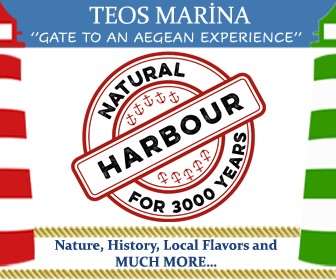Albania: A Nine-Day Coastal Adventure
Since their cruising adventure began in 2015, Aussie sailors Phil and Maree on SV Red Roo have ticked off 23 countries on their list. Country number 24 was Albania, where they received a warm welcome, enjoyed some wonderful hospitality and beautiful sights as they made their way up the coast.
Published 2 years ago

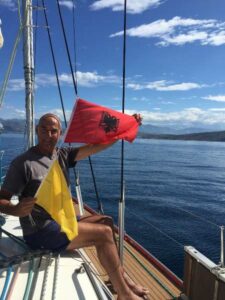
- Raising the Albanian and Q flags as we enter Albanian waters.
We could see Albania from our final anchorage at Corfu in Greece and it took us just over three hours to arrive. Albania is country number 24 on the great adventures aboard Red Roo. We called the Sarandë Harbour Master on VHF and were given permission to anchor in the bay and instructed to contact our agent to arrange the formalities of checking into the country.
After dropping anchor and securing the boat, our agent met us at the dinghy dock and took care of all formalities for us, all we had to do was pay her! We didn’t even have to show our faces at customs, our agent took our passports and returned them to us with an Albanian entry stamp in them. So Easy.
All Set for Albania
We took the afternoon to have a casual stroll around our arrival town Sarandë, we changed some money (Euros to Lek), got a new internet SIM card and we were all set for Albania.
We didn’t have a set agenda for Albania, it really depended on the weather. It isn’t a huge coastline (155 nautical miles), but it is exposed to any south or west winds, so our plan was to keep an eye on the wind and swell and time so we didn’t end up uncomfortable or exposed at anchor whilst making our way north.

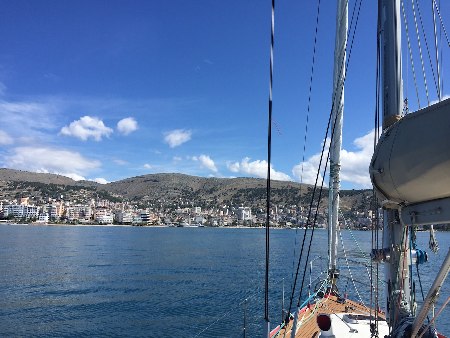
- Anchored in Albania
Before arriving we knew very little of Albania. In the last month we had been researching a lot about sailing, customs formalities etc but more generally the country remained a mystery for us to explore.
Size wise Albania is small it is about 340km long and 150km wide (Tasmania is twice the size of Albania). The terrain we witnessed both exploring inland (in the south) and sailing along the coastline is that it is very green and lots of rocky mountains. Doing some google research I learnt that Mother Theresa was Albanian and from speaking with locals we learnt that many of them speak perfect English.
The main tourists to the country are Italians, as Italy lies just 80km west across the Adriatic Sea with regular ferry services. The supermarkets & beach front restaurants are also influenced by Italian flavours.
Speaking with our check out agent in the north of the country he told us how Albania is known worldwide (backed up by google) for its religious tolerance. The two main religions are Islam and Christianity, and it is a country which respects all religions. He also told us that the average income for Albanians is around €400 a month and a good quality rental apartment in a town/city is €300 a month, that doesn’t leave a lot for them to live off.
Exploring the countryside
After checking in we arranged a hire car for the following day to allow us to explore a little inland whilst in the south of the country. We had a great day with some very picturesque scenery and great stops.
First stop was “Blue Eye” a natural water spring near the village of Muzinë. Parts of the clear blue river and springs can be seen to a depth of more than 50 meters. It is the initial water source of the Bistricë river which ends in the Ionian Sea south of Sarandë. The source of the spring is at 152 meters above sea level as has a discharge rate of up to 18,400 l/s. Surprising to us in the summer of 2004 the source temporarily dried up. The photos don’t do the water justice, it was SO CLEAR. We were looking at very deep patches that felt like you could touch the bottom. The other thing to note was that the water was cold, very cold, the information board said a constant 12 degrees but I am pretty sure it wasn’t that warm.
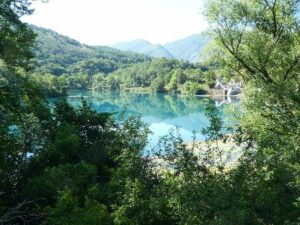

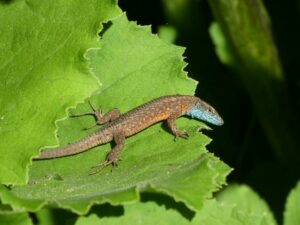

Next we drove up and over the mountains (and down the other side) on a rather old windy road to read the old town and castle of Gjirokastra a UNESCO world heritage site. It is described as a rare example of of a well preserved Ottoman town built by farmers of a large estate. The town is overlooked by the Gjirokastër Fortress (castle).
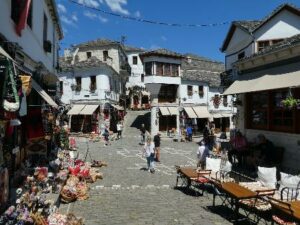

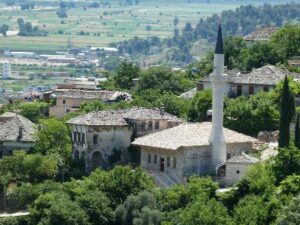

The first offical record of the city appears back in 1336 in Greek records. The city’s wall date from the third century and the high stone walls of the citadel were built from the six to the twelfth century. Looking down from the castle over the old town it was beautiful to see all the old slate tile roofs. Still to this day laid by hand without using any type of glue or adhesive and often having to be moved around a little in winter when it rains to stop a leak penetrating the roof.
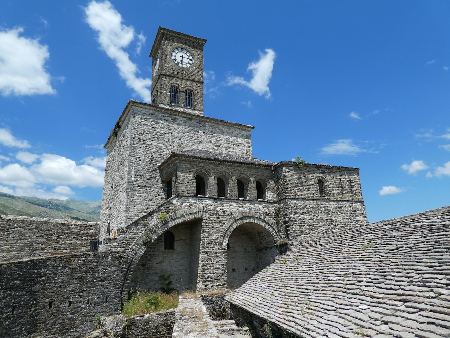

We enjoyed a traditional Albanian lunch in the old town here, we searched out the least touristy place, finding a lovely small “Grandma and Grandpa” run place in the back streets.
Through broken English and Albanian we told them we wanted traditional food, Chef Grandpa insisted we sit at the table he was at as “it was the best in the house” (we were the only customers), and Grandma selected our dishes; “Qifqi” (rice balls with herbs in a chicken broth) & “Tasqebap” (goluash) and of course Phil also drank his first Albanian beer.
The meals were traditional, small, delicious and cheap perfect for lunch. And of course we forgot to photograph (taking pictures of food doesn’t come naturally to us, but somehow we ended up with a picture of the beer?).
On our return to Sarandë we went via the Butrint National Park, castle, ruins and old ferry to cross the river and finally via the beach town of Ksamil.

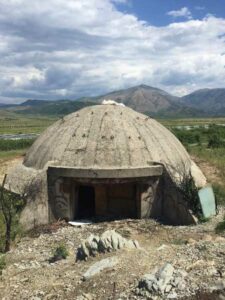
- One of the many concrete bunkers dotted throughout the countryside of Albania.
During our day in the car we were playing a lot of “spot the bunker”, which continued once sailing north in Red Roo all along the coast. Albania has over 750,000 concrete bunkers spread out across the land. They were built during the dictatorship of Enver Hoxha to protect the country from an invasion – which thankfully never happened. They are a reminder to all of the 50+ years of Albanian isolation.
North to Himarë and Vlorë
Lifting anchor on day three, we moved 20 nautical miles north to the smaller beach town of Himarë. We dropped anchor and were then visited by the local police boat who kindly asked us to move anchor further out from the beach, we most certainly could and did. The water here was absolutely lovely, clear and blue and the beach very attractive.
Day four was onto Vlorë 40 nautical miles north. Vlorë is a bigger town and the following day (day five) we walked 12km along the promenade and up the main street to the Square of Independence.

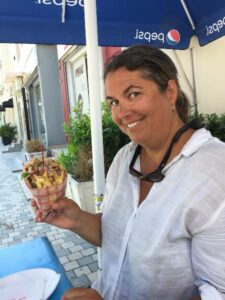
- Maree enjoying a “gyros”.
On our return we found a small Greek Gyros place and paid 200 Lek (€1.68) for a gyros. It was delicious and it made up for the last one we had in Corfu which was both expensive and not overly nice.
I commented to Phil that in many countries that we visit it is quite obvious who the locals are, they genetically tend have similar body shape, hair colour, stance, skin colour etc but in the few days we had been in Albania I was seeing such a diverse range of people I wouldn’t be confident in describing or picking out the typical look of a Albanian.
Arriving at Durrës under sail
The next day (day six) was a full 10.5 hours on the water to cover 58 nautical miles to Durrës. It was nice to have a good sail for some of that passage and motor sail the rest. In fact we were sailing into Durrës so hot (aka fast, well it felt fast after all the recent motoring) we were doing about 6.5 knots over ground that the harbour master called us on the VHF and warned us that the water is shallow, (aka, slow down) well his english words were “not much water” but we knew what he meant. We were watching the depth gauge and had read on the charts about the shallow bay.


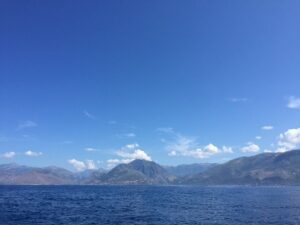

The bay of Durrës is large and very shallow for a long way out. We have a lifting keel so when it is up we only need 1 meter of water to float, which allowed us to go in a lot further than many other boats. We anchored in 2.5 meters of water at high tide, which at low tide was little under 2 meters. I was surprised to find a tide up here, it hasn’t been evident anywhere else in the Mediterranean. Even being in 2 meters we were still a long way out from the beach. Another boat anchored the following day and he was at least a nautical mile off the beach.

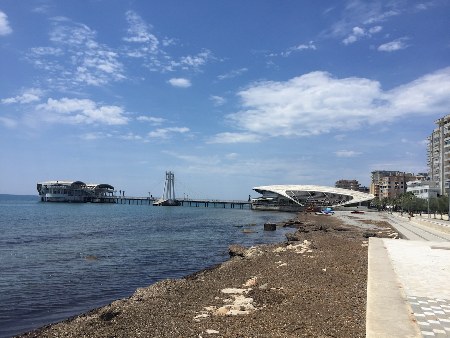
- The waterfront at Durrës.
We ended up staying four nights in Durrës, not because it was the best place, (the other places we had stopped were all a lot nicer as Durrës is an industrial port town), but we stayed due to the influence of the weather (no wind to sail), and we didn’t want to check out of a country and into another on a weekend as it can be hard getting officials in some countries on the weekends. We again took to the streets walking and exploring and found a very strong Italian influence in the town in regards to menu’s and supermarket offerings. Then speaking with our agent at checkout he informed us there are three ferries running daily, 2 to Italy and 1 to Montenegro. So the main tourism is influenced by the Italians. On our last day we took the dinghy into the commercial port to meet our check out agent. We tied our little dinghy up beside the police boats and tugs (we felt very small), then climbed the 2 meter wall (lucky there were old tyres and ropes hanging) to get to the dock. Within an hour we had our clearance certificate from Durrës Port Control and our passports stamped and we were approved to leave the following morning, and to anchor one more night in Albanian waters as long as we stayed on the boat and didn’t go to shore.
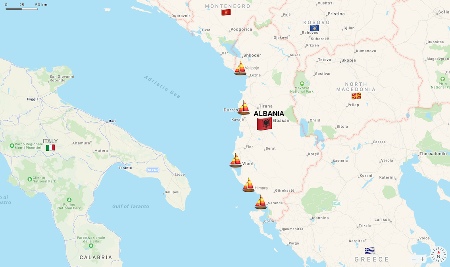

Next stop Montenegro
It was 37 nautical miles to the Albania/Montengro border which is defined by a river, and we anchored just inside the Albanian side off Velipoje Beach for our last night in the country. Again the water was shallow a long way out so it felt like we were anchored out to sea.
During our time in Albania the only real word we managed to master was “faleminderit” which is thank you. Faleminderit Albania for having Red Roo and crew visit your country.
Next we enter Montenegro (country number 25).
Maree and Phil
SV Redroo
…………………………………………………………………………………………………………………………………………
About the Authors:
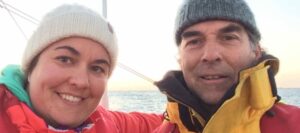

Maree met Phil in 2003 and after hearing about his plans to one day buy a boat and sail into the sunset, she decided it was an adventure she wanted to join in on.
So, in 2015 they packed up their life in Australia and flew to France to start their sea life aboard SV Redroo, an Alliage 38 which is a French designed and built aluminium centerboarder for blue-water cruising. They plan to return to Australia one day.
They keep their website updated with cruising adventures: https://Redroo.net
………………………………………………………………………………………………………………………………………
Posted from Redroo’s website with kind permission of Maree and Phil.
………………………………………………………………………………………………………………………………………
The opinions expressed in this article are the author’s own and do not reflect the view of Noonsite.com or World Cruising Club.
Related to following destinations: Albania, Corfu Port (Corfu), Durres, Greece, Himare, Ionian, Montenegro, Saranda, Vlore (Valona Bay)


